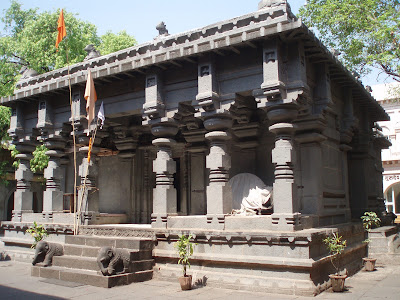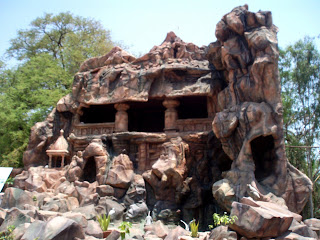Kaneri math is the monastery of the Kadsiddheshwar commune. A Shivalinga was first established here in the 12th century by Swami Samarth Revannath, a lingayat ascetic and a part of the Navnath (order of the 9 yogic teachers) parampara , and the founder of the Kadsiddheshwar monastery. The land was later developed by a latter high priest in succession, Shri Kadsiddeshwar maharaj , sometime in the 16th century.
Kaneri math is located in the Kaneri village in the Karveer tehsil in Kolhapur district. It lies on a road (5kms from the Gokul Shirgaon junction) which can be accessed from the Mumbai Kolhapur highway.
Today besides the monastery, the sprawling seven acre commune houses the Shiva Mahadeva temple , a 42 feet tall Lord Shiva idol and a museum that depicts the rural lifestyle in a typical Deccan village as it was a hundred years ago.
The Shiva temple is built within the boundary of a stone temple wall, having a Nagarkhana at the entrance, so typical of the Maharashtra temples and palaces. The temple itself is built in black basalt stone. The shikhara resembles some temples found in the Uttar Kannada region, similar to the Kadamba Bhoo Varaha temple found near Khanapur. The vimana is made up of layers having teeth like structures, ascending into a cone like formation.
The main temple has some beautiful sculptures at its doorway. Some are elephants , while some resemble the Sharabha (mythical half bird half beast with fantastic streangth, generally associated with Shaiva texts) shilps shown devouring the elephants.
The Sabhamandap (assembly hall) is supported by wide carved pillars.
There is a huge ornamented Nandi idol in the sabhamandap besides the Shivalinga in the Gabhara (sanctum).
It is said that the temple was frequented by Chatrapati Shivaji maharaj and his son Chatrapati Sambhaji Maharaj.
The temple premises also houses some minor temples and a 5-10 feet model of Lord Shiva shown seated on a hillock.
There is a 125 feet deep well in the premises, besides the dharmashala (resting rooms) and a modern structure which serves as a meditation chamber.
The meditation chamber is made in white marble and has a statue of the last Kadsiddheshwar maharaj in the centre.
One has to first climb down stairs ( flanked by huge elephant statues with musicians & people atop ) to come face to face to a 42 feet monolith statue of Lord Shiva along with a huge statue of Nandi maharaj, his carrier (the sacred bull).
While one proceeds to the museum, one sees onway several small statuettes of animals, birds etc.
Across is also a small cafeteria, a shop selling temple memorabilia and handicrafts.
The museum dispays the entire spectrum of village life. It has clay(wax?) models depicting the division of labour in villages in form of the ‘balutedars’ and the ‘alutedars’.As per the ancient Deccan labour system, there are 12 balutedars viz. 1) Mang (Rope maker) 2) Mahar (Watchman ) 3) Sutar ( Carpenter ) 4) Lohar ( Blacksmith ) 5) Kumbhar ( Potter ) 6) Chambhar ( Shoe maker ) 7) Nhawi ( Barber ) 8) Sonar ( Goldsmith ) 9) Joshi ( village astrologer ) 10)Parit (Washerman) 11)Gurav (Idol-Dresser) 12)Koli ( Water Carrier ) and 18 alutedars (whose work is considered less important than the balutedars).Others being the Ramoshi (guards), Potdar (silversmith),Kulkarni/Chougula(accountant) etc.
There are also models of the ancient Indian educationists, researchers,scientists, surgeons, astronomers,philosophers and technologists which provide an insight into the richness of our ancient culture.
There is also a section that displays several zodiac signs in clay.
Some of the models on display are(as under)Sowing (Perni), Covering the seeds (Kulavni and Rasani, Kulav is an instrument for leveling the land),Thrashing: the farmer scatters the ears of the corn and drives the bullocks over them (Malani),Uprooting the weeds ,Ploughing (Nangarani),Fanning the grains after the malani. The foodgrains are fanned on a tripod, the grains are collected in a sack and taken home in bullock carts,Watering the crops using a Mota (bucket of draw well),Gram Vihir (Village well),The shetkaris (farmers) house,The sutars (carpenters) house,The kumbhars (potters) house,The patharvats (stone masons) house,The Lohars (ironsmiths) house,The tambadis (coppersmiths) house,The Koshtis ( weavers) house,The chambhars (cobbler) house,The Kolis (fishermans) house,The buruds house (makes brooms and baskets),The vaidu’s (doctor) house, Sonars (goldsmith) house, Gurav (Idol dressers) house, The kirtan (people singing devotional songs in the temple), Women at Godess Laxmi (godess of wealth) temple, The Somwar katta where villagers exchange stories, gossip, At the Chavadi (where taxes were deposited), The Joshi (astrologer who prepares horoscopes and decides the auspicious time for rituals, ceremonies and festivals), The Patils (village headmans) horse, Dhangar (sheperd), A grandmother stitching a quilt., A newly married bride bidding farewell in tears to her parents, Grocers shop, Oil millers house, Nalband (nailing the shoe on the hoof of a bull), Nhavis (barbers) house, Bhaaji katta (where vegetables are sold), Soothsayer, Dalan (grinding flour),
Bangle seller, Aryabhatta (476-550 AD) the ancient mathematician and astronomer. Father of the decimal number system, Kashyap the ancient ayurvedacharya and surgeon, gynaecologists, paediatrician, obstetrician, Panini (6th cen BC) the ancient sanskrit grammarian, Varahamihira (505-587 AD) the astronomer and astrologer, Bhagiratha the technologist (ancestor of Lord Ram, born almost 5000-6000 years ago). Also instrumental for channelising river Ganga in the subcontinent. Ganga is also called Bhagirathi after him, Bharatmuni (400-200 BC) the teacher of performance arts and music.Authored Natya Shastra, a treatise on drama, Kapil the vedic author of sankhya(enumeration)system of Indian philosophy, Vachaspati Mishra and his spouse Bhamini (900-980 AD) who were scholars and logicians. Founder of one of the Advaita Vedanta schools, Kaanad (600 BC) atomic scientist and alchemist. Talked about the bi and triatomic molecule theories, electrons, gravitational force, when these concepts were unknown to the west, Vishnusharma(3rd cen BC) the author of the text Panchatantra, a political treatise with parables.:
Note: The above photographs of the clay models have been downloaded from various online sources and also scanned from the postcards on sale at the museum, as photography is prohibited in the museum premises.
Kaneri Math and its Siddhagiri museum is indeed a must for every Indian. It not just caters to the spiritual aspect for the pilgrims and the faithful, but also provides a spectacular delight for the tourists.
Text and photographs (except the ones of Siddhagiri museum) by Abhijit Rajadhyaksha








































ReplyDeleteBlack magic Removal in USA, Canada is an antique system or procedure for getting someone to act the way they want. This was done mainly for positive results. It was also used for getting the desired result. As it is very powerful technique it can bring enormous power to the executer and the target,hence it should be handled very carefully. The one who plans for Black magic on anyone should be doing it for good reason and with the good conscience
Black magic removal in usa
Great insights! This was an engaging read
ReplyDeleteshiva idol for home